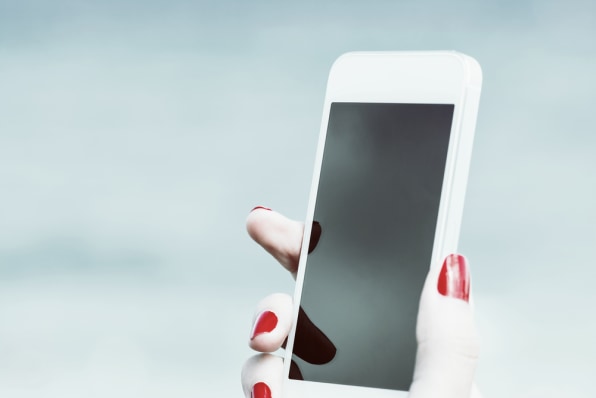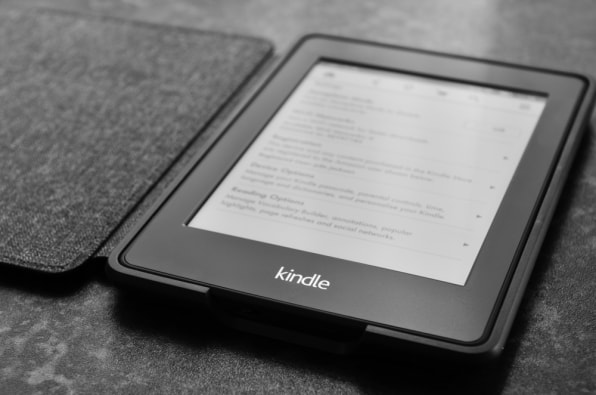Reading Your Phone Keep You Awake in Middle of Night
If yous're like near people, you probably snuggle upwards to your smartphone, tablet, or e-reader in bed before turning out the lights. This winding-down time is 1 of the just moments in the mean solar day where we accept the fourth dimension to leisurely catch up on our reading, emails, and social media feeds. Unfortunately for years, study later report have shown that using our favorite gadgets right before bed can have detrimental furnishings on our sleep and, over a long enough period of time, our wellness.
Still, it'due south not the mental stimulation from Facebook that is keeping us up. It turns out that our gadgets emit a type of low-cal that can mess with human biological science.
"Light has an astute alerting issue when it is transmitted from our eyes directly to our brains," says Dr. Victoria Revell, a senior project manager at the Surrey Clinical Research Centre at the University of Surrey in the U.K. "We know that it is bluish wavelength light that is particularly constructive at increasing alertness and affecting our body clock, and so we need to minimize the bluish/light-green wavelengths we are exposed to."
Unfortunately, virtually every device we ain, from the latest iPad to the Samsung Galaxy Note to Amazon's Kindle, has lite-emitting diodes that requite off blue wavelength calorie-free. And it'due south that bluish wavelength light that wreaks havoc on our body's melatonin production.
"Melatonin is produced past the brain at night and under atmospheric condition of darkness," says Dr. Mariana Figueiro, programme director at the Lighting Enquiry Center at Rensselaer Polytechnic Institute in Troy, New York. "It is known as the 'darkness hormone' because information technology tells the body that it is dark. In diurnal species, like humans, melatonin signals sleep and the body prepares to switch from daytime to dark style."
Figueiro says that blue low-cal suppresses melatonin, which fools the brain into thinking that it is daytime, making us feel more warning when nosotros should exist feeling sleepy since we're lying in bed. Over time, this melatonin disruption can be devastating.
"Disruption of the melatonin cycle resulting from irregular light/nighttime pattern exposure or exposure to light at the wrong time tin can lead to circadian disruption, which has been associated with poor slumber and poor performance," she says. If that behavior goes on for years, Figuerio says it can lead to diseases similar diabetes, obesity, and even cancer, although she likewise notes that the disease studies accept merely used animal models so far. However, Figueiro says "studies in humans take shown that rotating shift workers working at least twenty to 30 years on rotating shifts are at college risks for breast and colorectal cancer." Too, man research indicates that sleeping only 4 hours a dark can upshot in more hunger and college glucose levels.
But while in that location is no electric current "set up" for stopping our bluish light–emitting devices from messing with our melatonin production–and little hope people will stop using their devices in bed–both Revell and Figueiro say there are steps people tin take to limit the negative effects their devices take at dark.

1. Don't stop using your devices at night–but stop two hours before going to bed
Revell says that since our bodies only start to produce melatonin about 2 hours earlier our normal bedtime, there is no need to shun our devices just because it'south dark outside. That means if your normal bedtime is midnight, your trunk volition non beginning producing melatonin earlier ten p.m., so even if information technology'south wintertime and information technology's dark by 5 p.m., there should exist no adverse affects on your sleep patterns provided you end using your devices 2 hours before going to bed.
To really benefit from this advice, try to limit your gadget use to an hour or less the closer you become to your bedtime, says Figueiro. "Using an iPad for less than i hr–in the evening, before bedtime–has no significant affect on melatonin product. In our written report, melatonin suppression levels afterwards one hour of exposure to the iPad were not statistically dissimilar than zero; nonetheless, this deviation reached significance after two hours."
ii. Use devices with smaller screens
If you do need to use your gadgets to respond to that electronic mail in bed, Figueiro says it'due south marginally better reaching for your half dozen-inch iPhone than your x-inch iPad.
"What matters is the amount of calorie-free, specially brusk-wavelength (blue) light reaching the retina. A device that emits more blue light will be more than effective at suppressing melatonin," says Figueiro. "An iPad has the potential to impact united states more than an iPhone because it is larger and typically emits more than light."
She also notes that the closer the device is used to the eye, the more than low-cal the eye volition have in, so quickly checking a popup notification at arm'southward length is ameliorate than bringing it close up to your face to read it.
3. Turn the effulgence down
Though the quality and resolution of a display matters when you're shopping effectually for a device, the pixels per inch of your gadget won't affect your melatonin production–only the display'due south brightness will.
"It is the light being emitted by the device that is important, so the intensity, color, duration, and blueprint of the light are all important parameters in determining the response observed, says Revell. "The brightness is important with brighter calorie-free having more of an touch, up to a sure level."
The brighter a display is, the more light hits the back of our middle, leading to greater melatonin disruption. Turning the effulgence down in bed can reduce the amount of blue light hitting your middle. And while you're at it, don't be agape to appoint your device's "reading manner."
"Some devices have 'evening' modes where the calorie-free is dimmer and composed of the longer wavelengths, which have less of an impact on our physiology and behavior," says Revell.

4. Use an original Kindle (or a paper book)
Of class, y'all could always switch to a device without light emitting diodes. And when I say "device," I mean a good old-fashioned paperback book. The very starting time Kindle also lacked any kind of backlighting. Notwithstanding Revell cautions this method isn't foolproof.
"Exposing yourself to bright calorie-free immediately before bedtime will not help your sleep," she says. "This could be with a device or using a bedside lamp or the clip-on light for the Kindle."
That's where the adjacent chip of advice comes in.
5. Use smart lights
Our gadgets aren't the only devices that emit bluish light. The normal lightbulbs in our lamps practise, also. One way to rectify this–and enable you to read that book with a prophylactic amount of low-cal–is to use warm-colored lightbulbs in your lamps at dark. Of class, swapping out the bulbs in your lamps dark after nighttime would be a pain, merely thankfully there's now a wide array of smart lights–from the Philips Hue line to LIFX bulbs–which brand it easy to configure the blazon of light.
With a smart lighting organisation you tin can set the lights to automatically conform from a brighter blueish low-cal to a warmer colour a few hours earlier bed. The best role about these smart lights is yous can plan your settings into the app once and you never have to worry well-nigh remembering to adjust your lighting once again.
six. Use brandish-altering software
Speaking of low-cal-altering software, there are several apps for your devices that allow you to arrange the color intensity of the light emanating from your screens. Software like f.lux automatically adjusts the color of your display based on the time of day. The Android app Night Filter does the same thing.
"These are a skilful idea," says Revell. "It is the blue/green wavelengths that will have the about impact on your alertness and sleep patterns, so using orange/red lights in the evening will help, as these have less of an touch on on the body."
iPhone users should take annotation that Apple doesn't requite developers admission to controlling screen color and intensity on a arrangement-wide level, and so in club to use an app like f.lux you'll need a jailbroken iPhone. If you don't have a jailbroken device, you lot may want to remember of applying a physical filter like the Zzz iPhone Blue-Blocking Filter.
While Figueiro isn't familiar with the Zzz, she notes her team has "used an orange filter theatrical gel that removes whatsoever light beneath 530 nm. This is very constructive at cutting circadian stimulation to close to zero."
7. Article of clothing bister-lensed goggles
Instead of applying a software or physical filter to your devices, you lot could just choose to habiliment ane on your head. A number of vendors make amber-lensed goggles, which blocks the blue calorie-free from your devices and lamps from reaching your retina.
"These demand to remove manual of calorie-free beneath 530 nm," Figueiro says, "so not all of the amber-lensed goggles might be appropriate. Have the manufacturer specify the transmission of the glasses."
It's worth noting this method is a scrap extreme, every bit your entire world volition be bandage in an orange hue.
8. Become outside more than during the twenty-four hour period
This last flake of advice is my favorite, because it doesn't involve limiting the use of your devices or using artificial filters. In order to negate the effects of blue light at nighttime from your devices, you need to go outside more than during the mean solar day, where y'all can soak up a lot of natural blue light.
This might seem counterintuitive because the blue light from our devices often gets vilified, merely it'southward important to remember that blue light itself isn't bad for you. As a thing of fact, it'south essential for our biological functioning. We need blue light to warning our torso that it'due south daytime and it's time to get to work. Blue low-cal only becomes bad for you when you lot go likewise much of information technology at night. Thankfully, the more you get of information technology in the daytime, the meliorate your body is able to desensitize itself to blue light's effects at bedtime.
"The cyclic system is looking for contrast," says Figueiro. "If one is in a dim room all twenty-four hours, the body gets sensitized and volition respond to lower levels of light at dark. If i is exposed to high lite levels during the day, the sensitivity drops and one needs more light to affect the system at nighttime."
Source: https://www.fastcompany.com/3042717/8-ways-to-use-your-gadgets-at-night-and-still-get-a-good-nights-sleep
Belum ada Komentar untuk "Reading Your Phone Keep You Awake in Middle of Night"
Posting Komentar